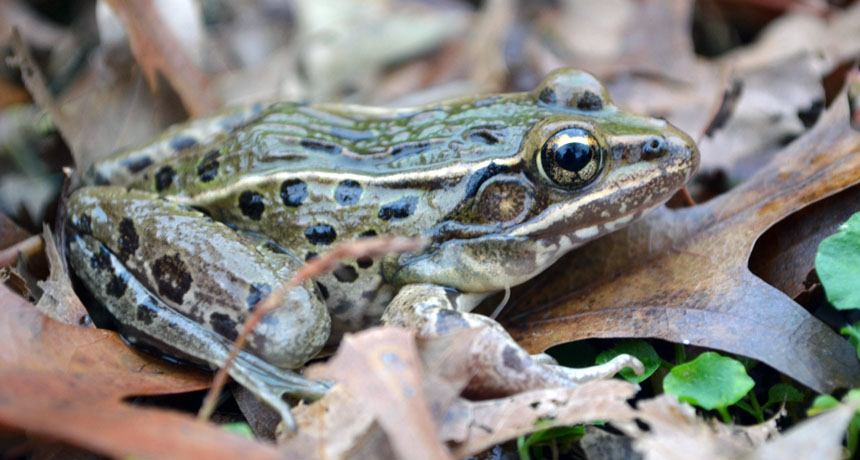New frog discovered in New York City
The frog lives elsewhere, too, but was first seen in a borough of the Big Apple

An Atlantic Coast leopard frog (Rana kauffeldi). This newly identified species lives in wetlands from Connecticut to North Carolina.
Brian Curry/Rutgers University
By Janet Raloff
Six years ago, ecologists identified a frog that might be a new species. It was living on Staten Island, a borough of New York City. Since then, scientists have discovered even more of these amphibians leapin’ across many sites along the eastern seaboard. The animal doesn’t look much different from the southern leopard frog. Only its croak gave it away.
“The discovery was unexpected,” say ecologist Jeremy Feinberg of Rutgers University in New Brunswick, N.J., and his colleagues. It’s hard to imagine, they say, that people could have missed a vocal species “in one of the largest and most densely populated urban parts of the world.”
These biologists have just confirmed the species is novel. They’ve named it the Atlantic Coast leopard frog (Rana kauffeldi). The frog’s scientific name pays tribute to ecologist Carl Kauffeld. Back in 1937 he proposed that the frog was a new species. At the time, though, he couldn’t prove it. So for the next 70 years, most biologists lumped this frog in with the southern leopard frog.
When Feinberg and his colleagues stumbled across the frog in 2008, they initially thought it might be a weird sounding southern leopard frog or northern leopard frog. Both are species in the Rana family. They even considered that the Staten Island frog might be a hybrid of the two species. The giveaway that something was different: this animal’s call. The newfound species’ call consists of single “chuck.” The northern leopard frog’s call sounds like a snore. And the southern leopard frog croaks as a pulsed series of “ak-ak-ak” sounds.
A given frog can make a number of different sounds, depending on what it wants to communicate. Feinberg’s team focused on the mating call made by males. Biologists refer to this as the guy’s “advertisement.” It alerts females that the guy is there, even if she can’t spy him right away. The scientists studied seven features of these ads. They included how long the call lasted, how long it took from when a call started until it became loudest, and the time between the first and last pulses in a call.
Of course, scientists couldn’t rely on song stylings alone to confirm this was a new species. For that, Feinberg’s team also sampled DNA from the frogs. In the October 29 PLOS ONE, they now confirm that the genetic fingerprint of the unusual croakers did not match that of other leopard frogs.
Tissue samples confirm the new species is living in freshwater wetlands and low-lying river floodplains along a narrow coastal range. It spans from Connecticut to northern New Jersey. Volunteers helped capture the frog’s distinctive call elsewhere, too. Based on those recordings, the species appears to inhabit wetlands as far south as North Carolina.
“We can still find new species not only in the rainforest or in remote areas of the world, but in places that are very familiar,” Feinberg told Science News. So keep your eyes — and ears — on high alert, he recommends. “Your backyard might just have a surprise.”
Power Words
amphibians A group of animals that includes frogs, salamanders and caecilians. Amphibians have backbones and can breathe through their skin. Unlike reptiles, birds and mammals, unborn or unhatched amphibians do not develop in a special protective sac called an amniotic sac.
DNA (short for deoxyribonucleic acid) A long, double-stranded and spiral-shaped molecule inside most living cells that carries genetic instructions. In all living things, from plants and animals to microbes, these instructions tell cells which molecules to make.
ecology A branch of biology that deals with the relations of organisms to one another and to their physical surroundings. A scientist who works in this field is called an ecologist.
floodplain The nearly flat land that runs along the side of a river, for some distance out from the water. When the river floods, it spills over into this plain, which is built up, over time, with the silt left as the waters recede. That silt tends to be soil that eroded off of the upstream lands during rains.
genetic fingerprint The unique set of genetic markers that identify an individual.
species A group of similar organisms capable of producing offspring that can survive and reproduce.
tissue Any of the distinct types of material, comprised of cells, which make up animals, plants or fungi. Cells within a tissue work as a unit to perform a particular function in living organisms. Different organs of the human body, for instance, often are made from many different types of tissues. And brain tissue will be very different from bone or heart tissue.
urban Of or related to cities, especially densely populated ones or regions where lots of traffic and industrial activity occurs.
wetland A low-lying area of land either soaked or covered with water. It hosts plants and animals adapted to live in, on or near water.







